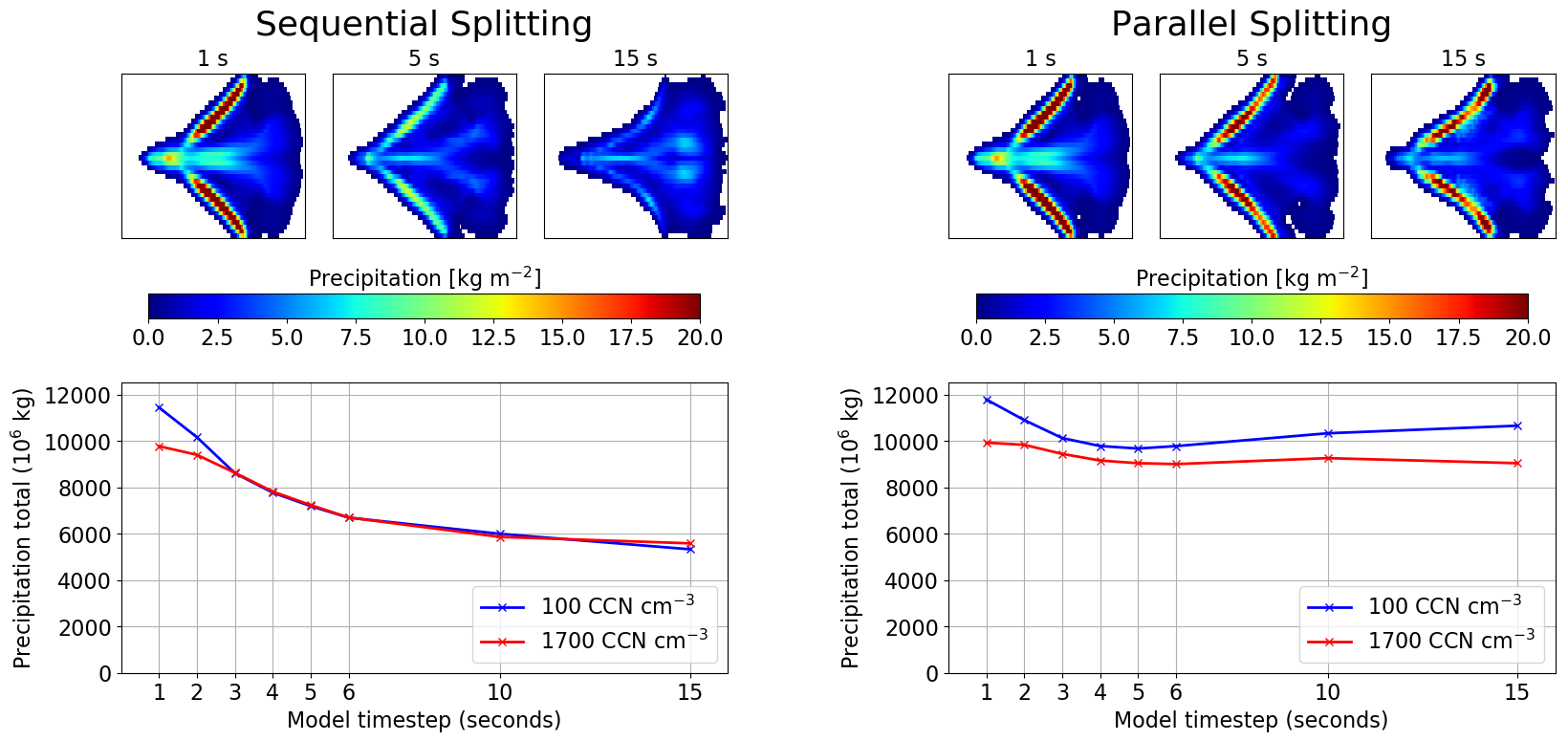One step at a time
| Figure: Maps of surface rainfall (top) and plots of total rainfall (bottom) as a function of model timestep. The left plots show results when sequential splitting is used; the total amount of precipitation reduces by around 50% when time step in increased from 1 to 15 seconds. Also, the regions with heaviest precipitation are reduced and the sensitivity to aerosol changes (CCN) are removed for longer time steps. The sensitivity of all three aspects to the time step are substantially reduced when using parallel splitting (right plots). |
In our research group, we use computer simulations to help understand how thunderstorms produce lots of rain and large hail stones (because flying aircraft inside thunderstorms to collect measurements is too dangerous). We also use these simulations to understand which properties of the atmosphere (e.g. temperature, humidity, horizontal and vertical wind speed, concentration of aerosol particles) affect thunderstorms. We are particularly interested in evolution of water vapour to water drops to rain and large hail. However, the processes affecting water drops inside clouds occur on such small scales that we cannot calculate the interactions explicitly. Rain drops growing inside thunderstorms are approximately 1,000,000 smaller than the thunderstorm and there are too many drops to follow each one individually. Therefore, the physics of these important “microphysical” processes within the cloud are “parameterized”, which means combining the physical equations with a statistical representation of the number and size of drops.
In our recent study [paper link here: https://agupubs.onlinelibrary.wiley.com/doi/full/10.1029/2018MS001418], we discovered that the “parameterized” physics inside clouds is much more sensitive to the how the physical equations are solved than was previously thought. This became obvious when we were forced to change the time step used in the model, and found very large changes to the simulated thunderstorm. The total precipitation reduced by around 50% when the model timestep was changed from 1 to 15 seconds. Also, the heaviest precipitation was significantly reduced, and the sensitivity to changing aerosol particle concentration (CCN) was removed (see Figure 1, left panel: “Sequential Splitting”).
We discovered that this was because of the order of the calculations in the model. In the computer simulations the processes are calculated sequentially: the air movements are calculated first – meaning that the air in the updraft region moves upwards and the temperature decreases - then the “microphysical parameterized processes” are calculated. This means that the calculations of these microphysical processes are then dependent on changes in the environment determined by the air movement; the size of the changes are dependent on the time step.
This is where the problem comes from. The microphysical calculations change substantially, and importantly nonlinearly, when the input temperature and humidity is changed. Because longer time steps lead to larger changes in temperature and humidity – the microphysics must then react to these larger changes. How it does that is very different to how it would react if the same temperature and humidity changes were applied over several smaller steps. The exact reasons for this are not simple to understand but relate to the interactions of the different drops inside clouds (small and large liquid drops and multiple types of ice particles such as snow and hail). In summary, the production of rain that can reach the surface is less efficient when the time step of the calculations is increased.
To avoid this problem, we experimented with different ways of ordering the calculations. The best setup we found was to calculate both the air movements and the microphysical processes at the same time (“parallel splitting” of the processes). This gave results that were much less sensitive to the length of time step used in the calculations than the “sequential splitting” used before. Using the parallel splitting, the simulated thunderstorm created large rainfall totals for all tested time steps between 1 and 15 seconds, the maximum rainfall totals were similar in all simulations and the sensitivity to aerosol concentration was consistent too (see Figure 1, right panel: “Parallel Splitting”).
This rather technical change to the model setup allows more accurate simulations of thunderstorms and also helps us determine the impact of atmospheric conditions on thunderstorms more reliably. Additionally, it allows good representation of the processes at long time steps – allowing faster computer simulations. Understanding how many other weather prediction models have the same sensitivity to the time step, and therefore could also be improved with this change to the ordering, is ongoing work.
[Working group: Cloud Physics]
Contact person: Prof. Dr. C. Hoose
22.03.2019

